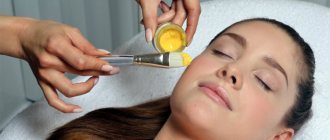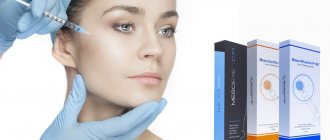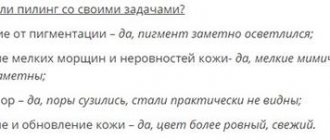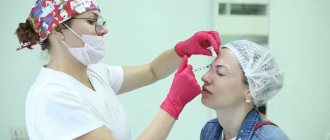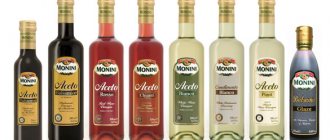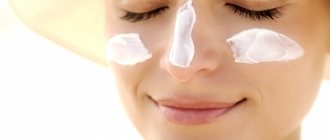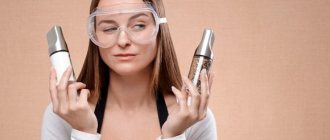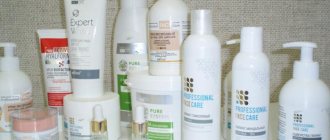What to do with rosacea
?
–
This question is more complex than it seems at first glance.
The problems underlying the causes of rosacea are problems not with the skin, but with blood vessels, so even after laser treatment for rosacea, spider veins may appear on the face again. Unconditional “once and for all” getting rid of rosacea, unfortunately, is not yet possible.
Fortunately, modern cosmetology has tools that help delay relapse or prevent it altogether.
But here, as the well-known literary hero said, saving drowning people is the work of the drowning people themselves. Some drugs and methods of modern cosmetology will be beneficial for rosacea, while others will only harm and provoke new spider veins.
What can be done with rosacea and what cannot be done with rosacea?
What is almond peeling?
Almond peeling belongs to the category of superficial peels.
And it is currently positioned as one of the safest and even “summer” peels. It is performed with preparations that include mandelic acid. Possible treatment areas: face, neck, décolleté, hands.
What is mandelic acid?
Mandelic acid is an alpha hydroxy acid (AHA), which is better known as fruit acid. The chemical name of mandelic acid is hydroxyphenylglycolic acid.
Mandelic acid is obtained from bitter almond kernels, which is why it is a completely natural product.
Basic properties of mandelic acid
- keratolytic effect (exfoliating): mandelic acid is able to destroy the bonds between individual scales of the stratum corneum of the epithelium and thereby promotes faster skin renewal;
- antiseptic properties: before the advent of antibiotics, the calcium salt of mandelic acid was used to treat infectious cystitis, and now it copes well with bacteria that cause acne;
- comedolytic effect: achieved in two main ways - exfoliation of the epithelium in the area of the mouths of the sebaceous glands and dissolution of blackheads when acid gets into the pores;
- relatively large molecules of mandelic acid do not penetrate deep into the skin, so the effect of almond peeling is limited to the epidermis;
- does not reduce the activity of melanocytes - the cells responsible for the appearance of tanning and hyperpigmentation, therefore pigment spots lighten and disappear only due to active exfoliation;
- does not affect the intensity of collagen and elastin formation in the skin: smoothing of fine wrinkles and narrowing of pores occurs due to a decrease in the thickness of the dead layer of the epidermis and an increase in its elasticity;
- Mandelic acid molecules penetrate the skin relatively slowly, so the peeling procedure can be performed on clients with thin and sensitive skin.
Medical cosmetics Anna Lotan
Anna Lotan's biocosmeceutical laboratory is located in Israel. The company's main priorities are product quality and safety.
The brand specializes in the production of medicinal cosmetics for sanatoriums, SPA centers, and beauty clinics. It is safe and approved for use in home care, subject to the recommendations.
Skin care cosmetics contain natural active ingredients and preservatives. They have a healing, restorative effect. Suitable even for sensitive skin with rosacea. From the brand's assortment you can choose comprehensive care for skin with different features. For young and mature. From foaming cleanser to healing mask.
Almond peeling for rosacea
Rosacea is not a contraindication for almond peeling. After the procedure, due to skin tightening, better hydration and normalization of the sebaceous glands, the severity of the vascular network may decrease. Due to exfoliation, papules (rosacea) may disappear. But almond peeling does not have any therapeutic effect on rosacea.
Indications for testing
- excessive oily skin, oily seborrhea;
- acne, post-acne, mild to moderate acne;
- the presence of foci of hyperpigmentation on the skin, poor complexion, signs of photoaging;
- hyperkeratosis, unevenness and bumpiness of the skin;
- the presence of small superficial wrinkles;
- melasma;
- lentigo;
- poor tolerance to glycolic peels;
- 3-4 skin phototypes according to Fitzpatrick;
- folliculitis.
Contraindications
- pregnancy and breastfeeding period;
- fresh tan;
- viral (warts, herpes, molluscum contagiosum), bacterial and fungal (microsporia, trichophytosis) skin diseases;
- the presence of purulent pimples on the skin in the treated area;
- the presence of abrasions, cuts, scratches and wounds at the site of peeling;
- decompensated diseases of the cardiovascular system and internal organs;
- oncology;
- colds accompanied by a rise in body temperature;
- diabetes;
- tuberculosis;
- psoriasis;
- atopic dermatitis in the acute phase;
- use of retinoids topically or orally;
- carrying out cosmetic procedures that injure the skin (microdermabrasion, laser, etc.) less than 4-5 weeks before almond peeling;
- allergy to any components of the peeling preparation.
After almond peeling, it is imperative to use sunscreen or powder with an SPF of at least 30.
Carbon peeling – “Hollywood cleansing” with lightning-fast results!
Every year, innovative rejuvenation techniques appear in the world of cosmetology - effective, safe, comfortable. One of them is carbon peeling, deep cleansing of the skin using nanogel and laser. Just 3-5 procedures - and your skin will be renewed, annoying pimples and acne will disappear, you will again experience admiration when looking at yourself in the mirror, and also catch the admiring glances of others.
Carbon peeling is express help before an important event: there is no faster method of cleaning
What is carbon peeling: mechanism of action
Carbon peeling combines laser exposure and photorejuvenation. A special gel mask containing carbon dioxide nanoparticles is applied to the face. That’s why the product is called carbon. Nanogel penetrates as deeply as possible into the skin, binds epidermal cells, attracts impurities and sebum residues.
With the help of this cosmetic procedure, it is possible to effectively combat various dermatological problems. The combination of laser with nanogel helps remove dead cells. The production of collagen and elastin, the synthesis of its own hyaluronic acid are stimulated, skin lipid metabolism is activated, and pathogenic microflora is destroyed.
Carbon – carbon: carbon dioxide nanoparticles work wonders!
Indications for laser carbon peeling:
- acne and comedones;
- early signs of photoaging;
- age spots and freckles;
- acne scars;
- enlarged pores on the skin;
- high fat content;
- dry areas with flaking;
- uneven structure and color, dull complexion.
Carbon peeling works great on fine wrinkles, evens out skin tone, and whitens skin.
How often to do
A course of carbon peeling to solve minor problems with pigmentation, to even out tone and texture is 3-5 procedures lasting 25-30 minutes, depending on the treatment area. Sometimes, with pronounced age-related defects, the cosmetologist recommends increasing their number to 6-8 sessions. The result will be noticeable after the first procedure, and will intensify with each subsequent one. The minimum interval between sessions is 5 days.
Carbon peeling can be combined with laser biorevitalization and thermolifting
Benefits of carbon peeling
- Low morbidity. The procedure takes place without trauma to the skin, so there are no complications after it, and there is no risk of infection.
- Comfort for the patient. During the session, the patient does not experience discomfort or pain and is in a relaxed state. The procedure does not require the use of anesthetics.
- Perfect result. Carbon gel demonstrates an excellent cleansing effect, and in combination with a laser, it narrows large pores, reduces sebum production, and rejuvenates.
- Quick results. Just 1-2 days are enough to exfoliate dead particles of the epidermis for the skin to rejuvenate.
- Versatility. You can take a carbon peeling course at any time of the year.
- Very short and easy recovery. Minor local phenomena are possible for several days.
With carbon peeling there is no redness and irritation, as after chemical exposure
How does the carbon peeling procedure work: stages
- At the preparatory stage, the cosmetologist examines the skin for inflammation. If there are any, he gives recommendations on how to eliminate them.
- The patient is first subjected to an allergy test for carboxylic acid (in case of individual hypersensitivity, peeling is contraindicated). Apply 1-2 strokes of the prepared mixture to the back of the hand and evaluate the result after 5-10 minutes.
- The face is cleansed of cosmetics and treated with antiseptic gel to eliminate pathogenic flora and prevent inflammation.
- The nanogel is applied to the treatment area for 5-8 minutes, and after drying it is treated with a neodymium laser (the patient’s eyes are protected with special glasses). The laser beam “explodes” carbon dioxide nanoparticles, resulting in the rejection of dead cells.
- After 10 minutes, the laser power is increased - the production of collagen, elastin, hyaluronic acid begins, which fills creases and wrinkles and smoothes the skin.
- The final stage is the application of a soothing composition or mask to protect against the harmful effects of the environment.
How is recovery going?
Complete healing of the skin after carbon peeling occurs after two weeks. On the day of the procedure, you should not wash your face; if necessary, cleanse the skin with soft foam or micellar water. For the first few days, it is advisable not to use decorative cosmetics, although there is no strict prohibition on this.
Skin care rules are quite simple:
- wipe your face with an antiseptic, for example, an aqueous solution of chlorhexidine;
- Avoid cosmetics containing alcohol;
- actively moisturize flaky epidermis;
- do not sunbathe or visit the sauna or solarium for 2 weeks;
- Before going outside, use sunscreen with a high level of protection;
- Avoid scrubs, skin polishing and other peelings for 2 weeks.
In the first 2 weeks after carbon peeling, you can make masks and undergo mesotherapy
In what cases is carbon peeling contraindicated?
The procedure will have to be abandoned under the following conditions:
- oncology;
- pregnancy and lactation;
- keloid scars (increased by laser exposure);
- vitiligo (possible pigmentation);
- melamine metabolism disorder;
- infectious and inflammatory skin diseases of a chronic nature;
- ARVI;
- individual intolerance to carboxylic acid.
At what age should I do it?
Carbon peeling helps solve dermatological and cosmetic problems for representatives of different ages:
- boys and girls - will successfully get rid of acne, inflamed pimples and unsightly spots;
- women over 30 will even out their skin, forget about the first wrinkles and traces of acne;
- women of advanced age will be able to fight the pronounced processes of skin aging, and will again remember what elasticity, smoothness and silkiness are.
Carbon peeling is a universal procedure that helps women and men look flawless. It has no age restrictions, is performed at any time of the year, and gives almost instant results. Do you want to look younger than your age, but are not ready for serious challenges? Then carbon peeling is the solution for you!
Questions and answers
How often can you do almond peeling? The classic course of almond peelings is carried out as follows: 1 procedure once every 7-10 days. 5-10 procedures can be performed per course.
According to indications, it is recommended to use almond peeling simultaneously with mechanical facial cleansing. When applying peeling before the procedure, it makes it easier to remove blackheads and pimples by loosening the skin.
Is almond peeling indicated in the summer and spring months? For healthy skin that is not prone to the formation of age spots, almond peeling will be safe. Especially if immediately after the procedure you do not visit the solarium and use sunscreen for at least the first three weeks. Almond peels are now often recommended for use during the spring and summer months. But there are certain restrictions for carrying it out for those who already have or have had pigmentation, regardless of the reasons that caused it. If there is pigmentation and you got rid of it not long ago, it is better to leave any peelings for autumn and winter.
This warning is due to the existence of a number of mechanisms in the skin to protect against harmful solar radiation, one of which is the thickening of the stratum corneum of the epidermis in the summer months.
Most often, the development of rosacea is provoked by the following factors:
- Genetic predisposition.
- Hormonal changes.
- Some diseases (liver, gastrointestinal tract).
- Bad habits – smoking, alcohol.
- Abuse of strong coffee and hot spices.
- Autoimmune processes.
Also, the condition of blood vessels is worsened by improper care or stressful conditions for the skin. For example, the cause of a decrease in the elasticity of capillaries can be too frequent visits to the sauna, errors during cosmetic procedures (improper steaming, injections), negative weather effects - frostbite of the skin, excessive exposure to the sun, temperature changes.
Skin care after yellow peeling
To avoid discomfort, swelling and irritation, it is recommended to use panthenol ointment in the first days after the procedure. Extracts of licorice, fireweed, shea butter and borage help soothe the skin and speed up recovery. You should not use products with retinoids and AHAs for two weeks.
After yellow retinol peeling, you can use only gel-like products for washing without aggressive surfactants and fats. Washing with cleansers is allowed on the second day. On the first day you cannot wash your face. After the procedure, the skin begins to actively peel off, crusts form - it is under no circumstances recommended to peel them off.
It is necessary to use a cream with UV protection of at least 30.
During the rehabilitation period, you cannot carry out some manipulations with your hair - dyeing it and doing perms.
Main indications and contraindications for yellow peeling
Since any acids, penetrating deep into the skin, enter the bloodstream, peeling with tretinoin is prohibited for use during pregnancy and breastfeeding. It is also undesirable to do it when planning conception: the exfoliation composition is harmful to the fetus, so it is recommended to carry out the procedure no later than a year before the expected pregnancy.
Retinoic peeling has other contraindications:
- inflammatory processes, chronic skin diseases, for example, herpes, eczema, rosacea;
- injuries, including scratches, wounds, burns, and warts;
- chronic liver diseases;
- hypersensitivity to the components of the composition, allergy, especially to vitamin C.
It is also unacceptable to cleanse while taking certain medications, including retinoids. In addition, when treating with certain drugs, you need to wait a while before the procedure:
- after antibiotics – 2 weeks;
- after Roaccutane – six months.
There are no age restrictions for the procedure. However, cosmetologists believe that it is advisable to carry it out after 30–35 years, and before that - only if there are scars or noticeable facial wrinkles on the skin, as well as with post-acne or inactive forms of acne.
Indications for retinoic cleansing include:
- uneven, dull complexion;
- pigmentation;
- lumpy skin;
- consequences of acne and acne;
- small wrinkles.
Causes of rosacea on the face
Cuperosis is a noticeable aesthetic defect that manifests itself in the form of a network of blood vessels close to the facial skin. The disease is a red flag for many cosmetic procedures, but there are a number of gentle peels that can eliminate the appearance of stars. Chemical and physical peels should not affect the deep layers of the epidermis - the main component of the compositions used should not penetrate deeper than the granular layer of the dermis.
With rosacea, the capillary and vascular mesh becomes noticeable and breaks through the skin. The walls of the blood vessels are very thin due to the disease, so if you act on them, you can only aggravate the situation. Consequently, if the cosmetologist overdoes it with the drug or the degree of exposure, the side effect will be the progression of the disease, the appearance of an inflammatory process and a reaction in the form of bruises and hematomas. A dermatologist has diagnosed rosacea - then to eliminate the defect, contact an experienced cosmetologist (peeling at home is strictly not recommended!).
Interesting to know: The symptoms of rosacea are very similar to rosacea, another vascular disease that is typical for older people. The disease manifests itself in the form of extensive red and pink spots in women over 50, who are frequent guests of cosmetologists. In this case, as with rosacea, a compromise solution is required - shallow and delicate exfoliation.
Reasons for the formation of rosacea:
- chronic disturbances in the functioning of blood vessels;
- physical inactivity;
- frequent stress that leads to high blood pressure;
- spicy and hot foods, especially coffee and chocolate;
- smoking and alcohol;
- thin and sensitive skin on the face, which seems to show through the capillaries;
- UV rays;
- temperature changes (for example, you visited the bathhouse and then went out into the cold).
The companions of rosacea are dryness and exfoliation of the stratum corneum of the epidermis.
Experts distinguish 3 stages of the disease. Their correct definition is very important in cosmetology, since patients with stage 3 are strictly prohibited from peeling, even the most delicate one.
Stages of rosacea:
- Itchy islands form on the face, which are characterized by peeling and redness. For those with oily or combination skin, this stage may go unnoticed.
- Stars or threads of capillaries appear on the cheeks, wings of the nose and chin.
- The formation of clearly visible purple spots and protruding vascular nodules. With such manifestations, cosmetic intervention is contraindicated - you need to fight rosacea only medically.
Properly selected peeling at stages 1 and 2 of rosacea solves numerous skin problems and minimizes visible spider veins. It allows you to:
- accelerate the regeneration of the epidermis, so after a while after peeling, the defect becomes less visible or disappears altogether;
- improve the microrelief of the skin, also eliminate spider veins that appear on the surface;
- rejuvenate, because wrinkles are eliminated and skin turgor improves;
- At the same time, remove other dermatological defects - acne, comedones, blackheads, etc.;
- minimize age spots and freckles.
Before performing the procedure, the cosmetologist must assess the condition of the skin. The presence of scratches, cracks and serious inflammatory processes in the dermis are a contraindication to exfoliation.
Attention! Treatment of rosacea is a set of measures that is not limited to peeling. You will need to take vascular-strengthening drugs internally.
What to do if the problem worsens after peeling
Exacerbation of rosacea during chemical peeling is quite possible. Incorrect concentration of acids, determination of the stage of the disease, or too thin skin become the reasons that the vessels are damaged even more and their mesh becomes clearly visible.
Hematomas often appear on the face, some taking on the appearance of “bloody dew.”
People with rosacea may develop persistent erythema - redness that does not go away for several days. In order to quickly get rid of such manifestations, you need:
- do not visit the bathhouse or sauna;
- stop eating hot and spicy foods;
- start taking Omega-3 fatty acids, which strengthen blood vessels;
- to improve microcirculation of the dermis, lubricate problem areas with heparin ointment, arnica extract, and lyoton;
- undergo a course of restorative physiotherapy with microcurrent.
Do not forget that if an allergy test is not performed, the patient may develop an allergic reaction, and even experience Quincke's edema, characterized by swelling of the tongue and difficulty breathing. It is necessary to administer antihistamines, and in some serious situations, immediately provide first aid.
Thus, peeling for rosacea is possible, but only with the permission of the attending physician. Knowing the stages of rosacea and the characteristics of the disease, your cosmetologist will select the necessary acids or perform enzymatic exfoliation. You will definitely be prescribed vascular-strengthening drugs and given a list of recommendations on how to care for your skin after the procedure.
Remember, performing chemical peeling even with weakly concentrated acids on spider veins at home is strictly prohibited. You can disrupt the already injured walls of blood vessels, leading to even greater redness and protrusion of the capillary mesh through the skin.
Types of peeling
There are different options for facial cleansing. When blood stagnates in the vessels, you need to resort to gentle compositions. That is why peeling preparations are characterized by a minimum concentration of acids and enzymes.
Chemical. Experts mainly use glycolic and lactic acid. The glycolic exfoliation procedure helps cleanse the dermis of sebum residues and other impurities, and also starts the rejuvenation process.
The molecule of the substance is negligibly small, so it easily penetrates cell membranes and simultaneously eliminates the unpleasant network of swollen capillaries. Milk peeling is more suitable for thin and sensitive skin.
In addition to its direct purpose, it fights age spots, freckles and even whitens the skin a little.
Other chemical peel options:
- mandelic acid - well suited for dark and tanned skin, gently cleansing it, has a good anti-inflammatory effect;
- low concentration retinoic acid masks spider veins, relieves skin irritation and prevents the appearance of rosacea in the future;
- phytin peeling, suitable for people of the older age group who suffer from dilated vascular mesh that appears through the skin of the face (large acid molecules cannot penetrate deeply into the epidermis, so they will not harm your blood vessels);
- Ferulic peeling helps strengthen tissues and blood vessels, and also has an antioxidant effect on skin cells;
- fruit peeling based on malic, citric or tartaric acid copes well with the manifestations of rosacea in the initial stages;
- Lactobionic peeling is an innovation in modern beauty salons - the acid is low-aggressive and perfectly relieves any inflammation in the dermis.
PRX t33. This special peeling contains 33% TCA, 5% kojic acid and hydrogen peroxide, which softens the aggressive effect of the key component. The product is produced by the Italian company WIQOmed and only recently entered the domestic market. Due to the high concentration of trichloroacetic acid, it is not used in the fight against rosacea.
TCA. This type of peeling is contraindicated for rosacea. Potent trichloroacetic acid can only harm the dermis. The only thing that cosmetologists practice is superficial intervention with a weakly concentrated product (up to 15%).
Roll up. Indicated for rosacea, rosacea and vascular mesh located close to the skin. It involves applying a special lotion to the skin (for example, Tony Moly peeling, Anti-Wrinkle Peeling Vegetal, Secret Key and many others) and massaging various areas of the face with fingertips. Then the product is downloaded along with the keratinized layer of the epidermis. After rolling out, all the pellets are washed off with ordinary warm water. This procedure really delicately cleanses the dermis without injuring it.
Jessner peeling. Cosmetologists agree that peeling based on salicylic acid should not be used to treat rosacea. The fact is that a 1st degree burn can affect the integrity of blood vessels. Although some specialists practice this type of peeling for vascular disease, it is still extremely undesirable.
Enzymatic. It not only provides hydration to the skin, but also perfectly combats deformations of blood vessels and capillaries on the skin of the face. For the dermis with signs of stage 1 and 2 rosacea, a composition based on lactic enzymes, bromelain, papin and trypsin is best suited.
Peeling with coral chips. The procedure is based on the abrasive effect on the skin of coral dust extracted from the marine life of the Red Sea. Can only be carried out for 2–3 minutes.
Carbon peeling. Involves photorejuvenation and laser treatment of the epidermis. A special nanogel penetrates quite deeply under the skin, helping to minimize wrinkles, improve metabolic processes, and most importantly, eliminate vascular networks. In addition, this effect tightens pores, smoothes out unevenness, and removes pimples and acne.
Oxygen or aqua peeling. The hardware procedure involves spraying a special mixture onto problem areas, which allows you to eliminate the stratum corneum of the epidermis (the product usually includes green tea extract and ascorbic acid). Significantly strengthens the walls of blood vessels and promotes their better throughput.
Radio frequency. Vascular diseases in the initial stages can be quite well treated by exposure to microcurrents and radio waves. Make an appointment with a cosmetologist, because such an effect will require special equipment.
For peeling to really work, the selected composition must be applied to problem areas last, and rinsing must be done first. For people with sensitive skin, the break between procedures is 14 days. In the intervals between sessions, the patient should use angioprotectors that will help strengthen the walls of blood vessels (for example, ascorutin, tincture of hawthorn and horse chestnut, fir and special multivitamin complexes are suitable).
Important point! It is not necessary to go to a cosmetologist to cope with the initial stage of rosacea. You can try a cleansing mask based on kaolin and crushed grape seeds. Women also loved the whitening mask, which combines honey, starch and warm milk. Anti-inflammatory peeling made by applying steeply brewed green tea has proven itself well.
Acid peels can have the opposite effect, especially if the patient has thin skin and serious age-related changes are noticeable. Thick, oily and dense skin gives the green light to the use of weakly concentrated acids mentioned above.
In most cases, cosmetologists resort to enzyme and enzymatic peelings. Of the acid peels, only superficial options can be used - low concentration acids (taking into account the skin type and the degree of the disease). Medium peelings are permissible only at the discretion of the cosmetologist. They are done, if necessary, with long intervals between sessions.
